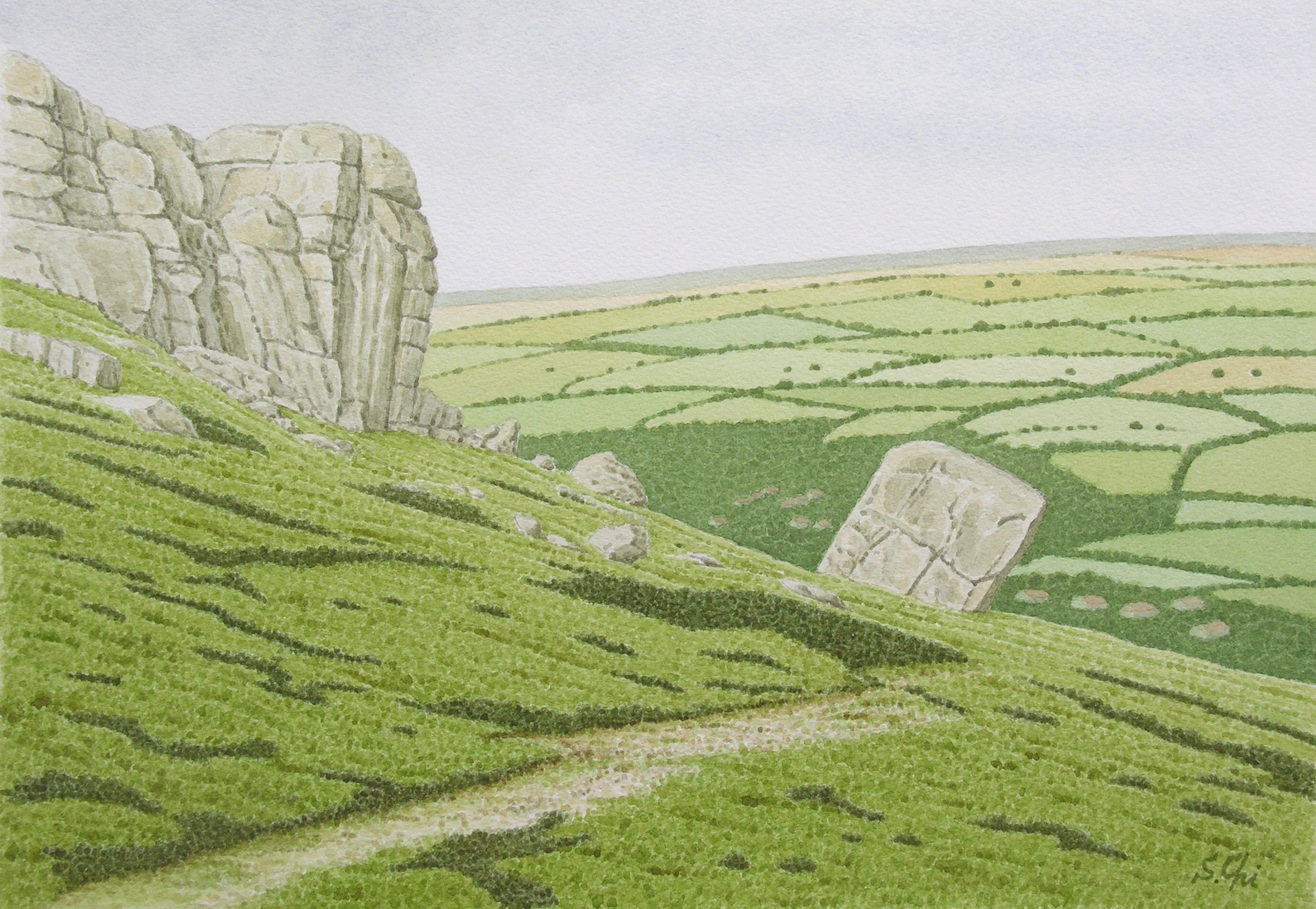
遥かなる わがヨークシャー (Faraway My Yorkshire)
ヨークシャー・デイルズ (The Yorkshire Dales)
36 イルクリー・ムーアの牛の母子岩 [ウォーフデイル]
(The Cow and Calf Rocks on Ilkley Moor, Wharfedale)

ここからは、すこし遠出をして、ヨークシャー北西部の丘陵地帯を歩いてみようと思う。
リーズの北の郊外には、西から東へと、ウォーフ川が流れている。この川がつくるウォーフデイルは、ヨークシャー・デイルズのなかで、もっとも美しいと言われている。
リーズから北西に22、3km行ったところに、そのウォーフデイルへの入口の町イルクリ―がある。このあたりは、デイルといってもまだ広々としていて、「谷間」といった感じがしないところである。
イルクリ―は古い歴史をもった町で、2500年以上まえの鉄器時代の遺跡と、ローマ時代に築かれた砦の跡があることで知られている。ローマ人は、この町を「オリカーナ」と呼んだ。
またイルクリ―は、温泉の町としても知られている。
この町の南側に、イルクリー・ムーアという丘が広がっている。そこに、「イルクリー・ムーアの牛の母子(おやこ)岩」と呼ばれて親しまれている岩山がある。丘の北側の縁が断崖状になって大きく迫り出し、町を見おろしている岩山である。
その断崖状に迫り出した岩山が「母牛」で、その下の斜面に転がり出たような四角い巨石が「子牛」なのだという。高さは、母牛が30mくらいで、子牛は10mくらいだろうか。
子牛の岩は、映画『カレンダー・ガールズ』のなかで、母親のヌード写真にショックをうけた高校生の息子が、そこに登って、友達とビンに入ったワインをラッパ飲みする場面として登場してくる。
かつてここには「父牛(ブル)」と呼ばれていた岩もあったというが、聞くも悲しいかな、19世紀に石材にされてしまったという。
イルクリー・ムーアは、「帽子もかぶらずにイルクリー・ムーアで」という唄でも知られているところである。
この唄は、「ヨークシャーの国歌」として親しまれている。唄の詩は、むかしヨークシャーに住んでいた部族のなかで生まれたもので、若者にたいして話しかける、次のような内容になっている。
「おまえを見かけたとき、おまえはどこに行っていたんだい。帽子もかぶらずにイルクリー・ムーアで(この節は、このあとにつづく一節ごとにくりかえされる)。メアリー・ジェインを連れていたね。そんなことをしていたら風邪をひいて死んでしまうぞ。そしたらみんなでおまえを埋めてやるぞ。すると虫がやってきておまえを食べてしまうぞ。すると鴨がやってきてその虫を食べてしまうぞ。すると俺たちみんながその鴨を食べてしまうぞ。すると俺たちみんなはおまえを食べちゃうことになるぞ」
この唄の誌は、「ムーア(荒野)を帽子もかぶらずに歩いていると、風邪をひいて死んでしまうぞ」と、単にいましめたものだという。
しかしそれだけでなく、食物連鎖からさらに再生、輪廻転生のような深い意味があるともとれる。また、カニバリズム(古代の食人習慣)を連想させるような不気味なものを感じさせるところもあり、謎めいた誌の唄である。
曲は、ハリファックスの教会の聖歌隊が、1886年にイルクリー・ムーアにピクニックに行ったときに付けたとされている。ところが別の説では、リーズの刑務所での絞首刑のときに生まれた、とも言われている。
「ヨークシャーの国歌」とされて無邪気に陽気に歌われる唄であるが、内容といい曲が生まれた経過といい、なんとも奇怪な唄である。
From here, I would like to walk around the Yorkshire Dales.
The River Wharfe runs in the north outskirts of Leeds. Along the south
bank of the river, the town of Ilkley spreads. The town is well known as
an ancient settlement going back to the Iron Age, more than 2500 years.
The Romans built a fort here and named it Olicana. In the 18th and 19th
century, Ilkley had flourished as a spa town.
In the south of the town, Ilkley Moor spreads. And at the north edge of
the moor, there are a crag and a large boulder, called "the Cow and
Calf Rocks on Ilkley Moor", looking down on the town. The crafg, a
gigantic buttress about 100 feet hifgh, is called the Cow, and the large
boulder like a cube of about 30 feet, on the slope under it, is called
the Calf.
In the cinema "Calendar Girls", a high school boy shocked to
see his mum's nude photo drank a bottle of wine with a friend of his on
the boulder.
There was a Bull formerly too, but it is sad to hear that it was broken up and used as building stones in the 19th century.
On Ilkley Moor, I wopuld remember the old folk song "On Ilkley Moor
baht' at", the national anthem of Yorkshire. The verses are said to
be old Yorkshire's tribal chants. The song warns us that being on Ilkley
Moor without a hat will cause to catch cold and die.
The verses also remind me of food chain or recycling, or having some deep
meanings and profound ideas like transmigration.
The song was composed by members of a Halifax church choir on their annual
outing to Ilkley Moor in 1886. But there is another tale, too, saying that
it arose from a hanging in Leeds jail.
The song is sung merrily and innocently, yet I cannot help feel something weird and horrible in it.